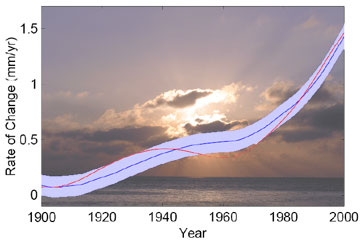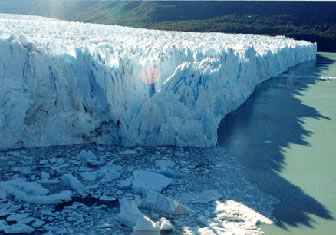Sea levels rising at fastest rate on record
Sea levels rising at fastest rate on record
Scientists criticize climate report on rising sea level projections
mongabay.com
February 1, 2007
A group of prominent scientists — include NASA’s James E. Hansen — criticized the Intergovernmental Panel on Climate Change (IPCC) climate report due to be released Friday.
Writing in Friday’s issue of the journal Science, the scientists say the IPCC report understates the risk of rising sea levels by not accounting for melting ice in Antarctica and Greenland.
“The data now available raise concerns that the climate system, in particular sea level, may be responding more quickly than climate models indicate,” wrote the authors. “Previous projections, as summarized by IPCC, have not exaggerated but may in some respects even have underestimated the change, in particular for sea level.”
The authors, led by Stefan Rahmstorf of the Potsdam Institute for Climate Impact Research in Germany, say that sea levels have been rising faster since 1990 than IPCC models projected.
“The satellite data show a linear trend of 3.3 mm/yr (1993-2006) and the tide gauge reconstruction slightly less, while the IPCC projected a best estimate rise of less than 2 mm/yr,” the authors continued. “The rate of rise for the last 20 years of the reconstructed sea level is 25% faster than the rate of rise in any 20 year period in the preceding 115 years.”


Top: Rate of sea level rise computed directly from the climate model simulation (red), and estimated using Eq. 1 driven by the global mean temperature from the climate simulation (blue). |
The scientists say that while the largest contribution to rising sea levels come from ocean thermal expansion and melting of non-polar glaciers, the rate of ice loss in Greenland and Antarctica is accelerating and could have an increasing impact on ocean levels.
In a December 2006 paper also published in Science, Rahmstorf said that global warming could cause sea levels to rise by one-and-a-half to four-and-a-half feet (50-140 cm) by the year 2100, well above the 9-88 cm projected by the United Nations Framework Convention on Climate Change. A 140 cm rise in sea levels could swamp low-lying cities like New York and Venice while causing catastrophic flooding in Bangladesh and South Pacific island nations.
“A rise by over one meter by 2100 for strong warming scenarios cannot be ruled out… [but] very low sea level rise values as reported in the [IPCC report] now appear rather implausible in the light of the observational data,” wrote Rahmstorf in the December Science paper. “The possibility of a faster sea level rise needs to be considered when planning adaptation measures such as coastal defenses, or mitigation measures designed to keep future sea level rise within certain limits.”
While he cautioned that sea level changes are dependent on poorly understood factors such as the rate at which glaciers and ice sheets melt in Greenland and Antarctica and the thermal expansion of sea water, Rahmstorf said that the lowest plausible limit to sea level rise by 2100 is 38 cm — around a foot.
“Understanding global sea level changes is a difficult physical problem, as a number of complex mechanisms with different time scales play a role,” he wrote. “For this reason, our capability of calculating future sea level changes in response to a given surface warming scenario with present physics-based models is very limited, and models are not able to fully reproduce the sea level rise of recent decades.”
In December, Rahmstorf compared his approach to predicting future sea level rise to estimating the height of tides along a coast based on past observations.
“We expect sea level to rise as the ocean takes up heat and ice starts to melt, until asymptotically a new equilibrium sea level is reached,” Rahmstorf wrote. “Paleoclimatic data suggest that changes in the final equilibrium level may be very large: sea level at the Last Glacial Maximum 20,000 years ago was 120 m lower, while global mean temperature was 4-7 ºC lower. Three million years ago, during the Pliocene, the average climate was about 2—3°C warmer than today and sea level was 25—35m higher.”
Rahmstorf said that this data suggest that sea levels rise on the order of 10-30 meters per degree Celsius over the course of thousands of years. The U.N. has projected temperatures will rise by 1.4-5.8 C (2.5-10.4F) by 2100 due largely to human-induced emissions of greenhouse gases that result from fossil fuel combustion and deforestation.
This article uses quotes from “A Semi-Empirical Approach to Projecting Future Sea-Level Rise” and “Recent Climate Observations Compared to Projections” published in SciencExpress, the online version of Science.







